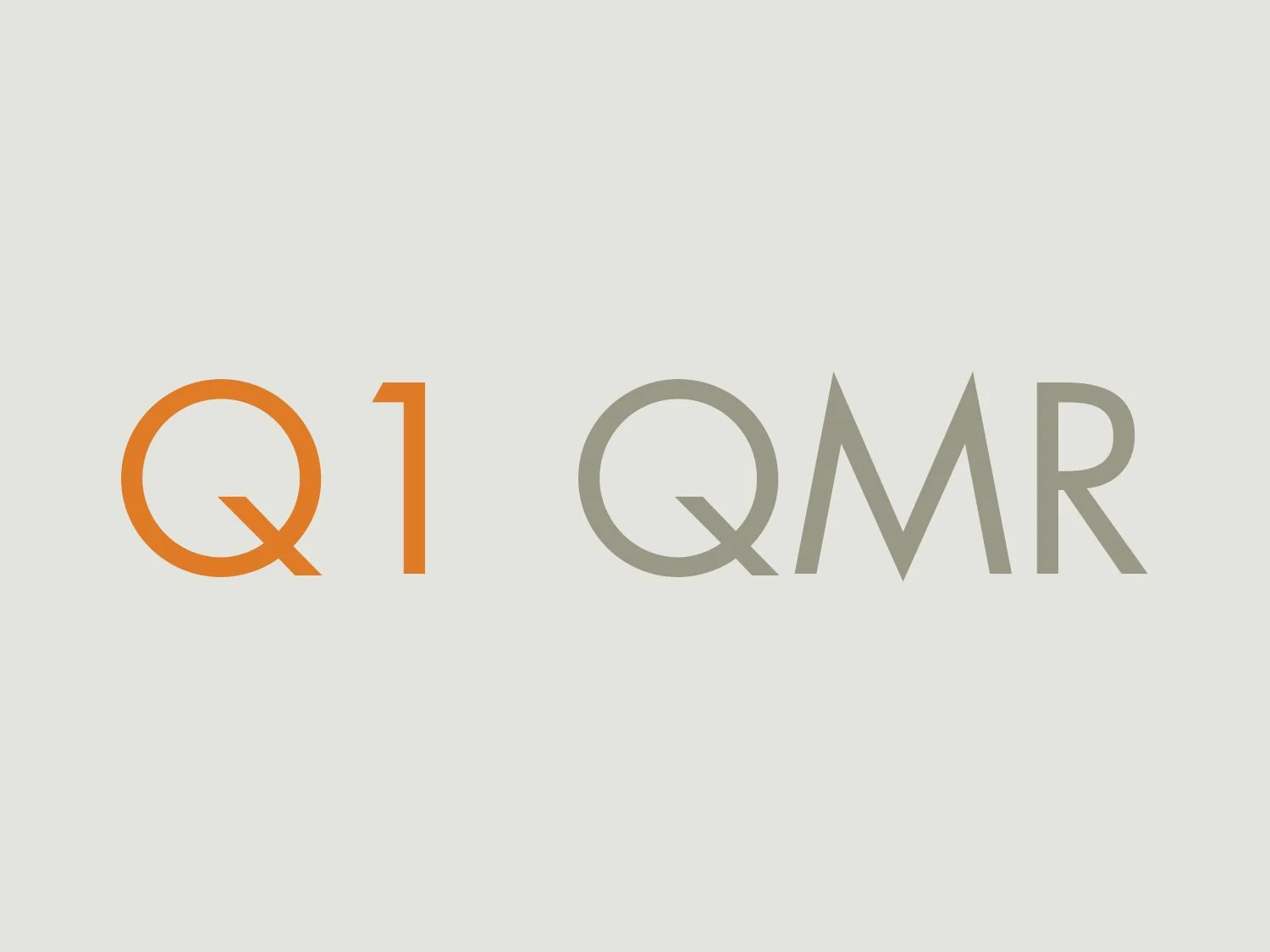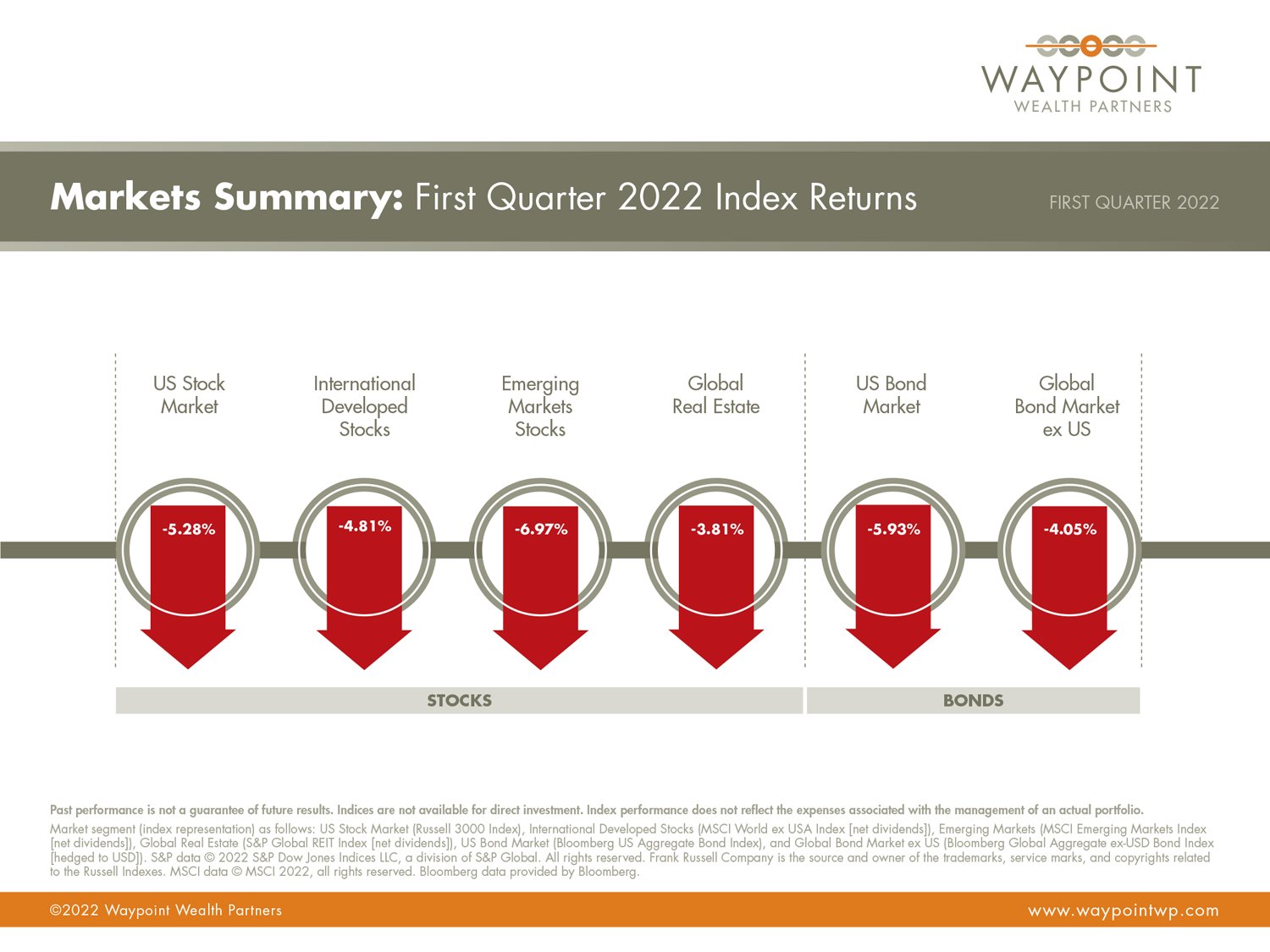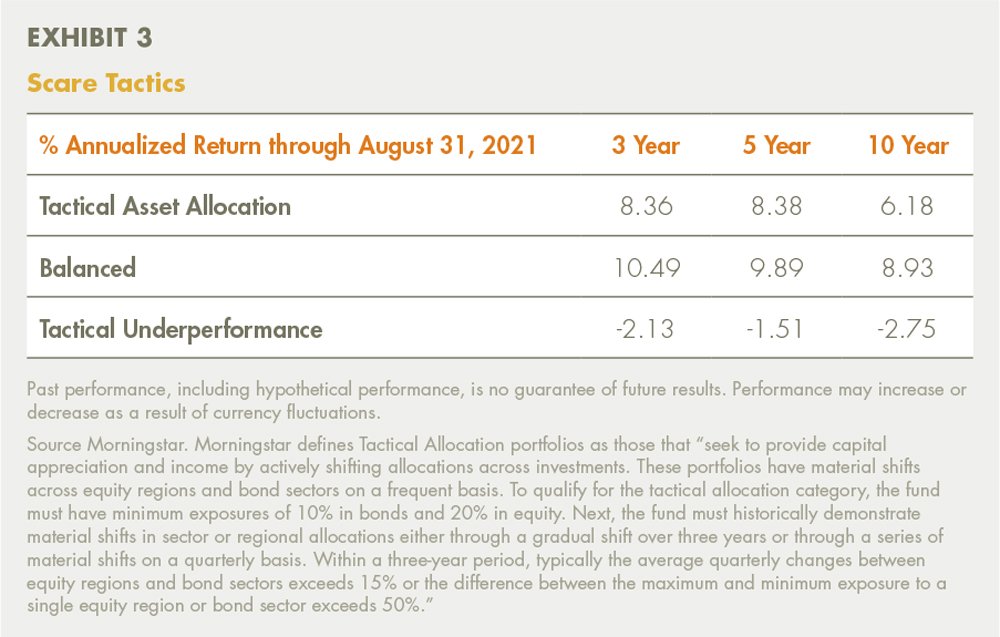ECONOMY
Economic growth slowed in the first quarter, with real GDP estimates around 2%, coming off a very impressive 7% growth rate in Q4 2021 and a full year of growth in 2021 like we have not seen in decades. A very tight labor market pushed unemployment lower and wages higher. As the impact of COVID eased in the U.S., more people, especially women, began returning to the workforce. This is a positive sign for economic productivity going forward.
The impressive growth we have experienced recently, coupled with strong demand from excess savings built up during the pandemic and the war in Ukraine, have led higher inflation to stick around longer than anticipated. Coupled with a very tight labor market, these economic conditions led the Fed to raise interest rates from ultra-accommodative levels, and to talk about decreasing the size of their balance sheet as early as May, which would further tighten financial conditions leading to decreased demand for goods and services.
All the economic uncertainty around war, shifting monetary policy, inflation, and spikes of COVID in Asia led to a very volatile quarter in global capital markets. All asset classes except commodities lost value. This is not surprising given the amount of uncertainty being priced into markets, though it can be unsettling after several years of above average market gains. These environments breed opportunity for long-term, disciplined investment strategies like the one we execute on your behalf. We took advantage by rebalancing and tax-loss harvesting throughout the quarter where it made sense to do so.
STOCKS
Global stocks, measured by the MSCI All-Country World Index (ACWI), were down about -5.3% during Q1. The value style strongly outperformed growth across global markets, and larger companies generally outperformed smaller companies over the quarter, except in emerging markets. Our long-term tilt toward value helped relative performance year-to-date. Still, we remain broadly diversified in our overall equity positioning. Earnings are expected to come down from recent records as companies begin reporting their first quarter results, though should remain at healthy, more normalized levels.
U.S. stocks (Russell 3000) were down about -5.3% in Q1. Energy was the best performing sector, influenced by the war in Ukraine, the price of oil and natural gas, and evidenced by surging gasoline prices. Our recommended U.S. stock strategies outperformed for the quarter, helping relative performance.
International developed stocks (MSCI Developed ex-US) outperformed U.S. stocks, losing -4.8% for the quarter. Canada, Australia, and Norway, heavy producers of commodities and oil, were top performers, while the Netherlands, Austria, and Ireland were detractors. Our recommended international stock strategies were in-line with the benchmark for the quarter.
Emerging markets stocks (MSCI EM) were down about -6.9% for the quarter. Peru, Brazil, and Colombia were up over 30%, while Hungary and Egypt were down around -20%, and Russia was removed from indices. Price swings happen quickly and are unpredictable, which is why we take a diversified approach in seeking to capture returns and manage risk. The wider range of outcomes and greater risk can lead to higher returns over time in emerging markets, but position sizing is important so instances like Russia do not derail our long-term goals. Our recommended emerging markets stock strategies outperformed the benchmark for the quarter, a benefit for our relative performance.
BONDS
Interest rates increased markedly across all maturities in the U.S. Treasury market for the quarter, leading U.S. bonds to their worst quarterly performance since 1980. This was suprising to markets given the Fed was expecting to raise interest rates only two times in 2022 as of the end of last year. They now anticipate raising interest rates 7 times this year. The hawkish change was priced into markets quickly. A fixed-rate, 30-year mortgage is now averaging over 5%. The largest impact was seen in the 2-Year U.S. Treasury Note, leading to a flattening of the yield curve. The 2-year yield increased 155 basis points (bps) to 2.28%, even putting near-term pressure on prices of high-quality, short-term bonds.
Given this backdrop, all bond sectors and maturity ranges had a very challenging quarter. The broad taxable investment grade bond index (U.S. Agg) was down -5.93% for the quarter. Global bonds ex-US (Bloomberg Global Aggregate ex-USD Bond Index, hedged to USD) were also down -4.1% for the quarter. Our active intermediate-term and short-term bond strategies added value relative to broader market returns, though it can still be unsettling to see losses in fixed income. Municipals didn’t fare any better, with the broad index down -6.23%, though our active managers were positioned with much shorter duration and outperformed the index.
Sharp yield increases lead to unrealized short-term capital losses on statements as prices move inversely with yields. However, by staying invested, the higher income will offset the price declines over the bond holding period, and total return will look more in-line with expectations. Future expected returns are higher now, and overall it’s a positive sign that the economy is healthy enough to support higher interest rates.
Throughout this environment of low and rising interest rates, we have maintained a higher-quality and shorter duration fixed income stance to weather downturns. Fixed income continues to be our portfolio’s protection and ballast. While it may not seem so during this quarter, we need to keep in mind that fixed income has exhibited one third the volatility of stocks, and over longer time periods, stock and bond returns have been negatively correlated.
REAL ESTATE
Global real estate (S&P Global Real Estate) was also down -3.8% for the quarter, outperforming both broad stock and bond markets for the quarter. Rising interest rate environments can be more challenging for real estate investors, and our recommended strategy underperformed the broad index for the quarter. We are assessing this asset class for additional opportunities as part of our ongoing due diligence and will keep you apprised of any updates to our thinking.
——
Quarterly Article: Is It Time to Sell Stocks?
After touching record highs in early January, US stocks¹ have slumped, and investors have been confronted with worrisome headlines² in the financial press:
“Inflation Hits Fastest Clip Since ’82”
—Gwynn Guilford, Wall Street Journal, January 13, 2022
“Economists Cut Back Growth Forecasts as Threats Pile Up”
—Harriett Torry and Anthony DeBarros, Wall Street Journal, January 18, 2022
“Giant Stock Swings Send Some Into Bear Territory”
—Gunjan Banerji and Peter Santilli, Wall Street Journal, January 18, 2022
“Markets Drop as Turbulent Trading Persists”
—Gunjan Banerji and Will Horner, Wall Street Journal, January 26, 2022
“Fed Set to Start Increasing Rates by Mid-March”
—Nick Timiraos, Wall Street Journal, January 27, 2022
Some stocks that attracted intense interest last year have fallen sharply from their previous highs, as Exhibit 1 shows.³
Is rising inflation a negative for equity investors? Do large losses in a handful of popular stocks signal a downturn ahead for the broad market?
Invariably, the question behind the question is, “Should I be doing something different in my portfolio?” This is just another version of the market timing question dressed in different clothes. Should I sell stocks and wait for a more favorable outlook to buy them back? More precisely, can we find clear trading rules that will tell us when to buy or hold stocks, when to sell, when to admit our mistakes, and so on?
The lure of successful trading strategies is seductive. If only we could find them, our portfolios would do so much better.
Consider Felicity Foresight. She is gifted with the ability to identify patterns in the champagne bubbles floating to the top of her glass on New Year’s Eve, enabling her to predict the best performer between S&P 500 stocks and US Treasury bills over the subsequent 12 months. How would her hypothetical portfolio have performed over the past 50 years following this simple annual readjustment strategy?
Rather well. Following a Perfect Timing strategy by investing in the best performer each year, she turned $1,000 into $1.8 million, nearly 10 times the wealth produced using a buy-and-hold strategy for the S&P 500 Index (see Exhibit 2).
But also consider Hapless Harry. He was never a fan of New Year’s and manages to get it wrong each and every year. His Perfectly Awful strategy winds up losing money over the same 50-year period.
Motivated by the substantial payoff associated with successful timing, researchers over the years have examined a wide range of strategies based on analysis of earnings, dividends, interest rates, economic growth, investor sentiment, stock price patterns, and so on.
One colorful example, known as the Hindenburg Omen, had a brief moment of fame in 2010. Developed by a blind mathematician and former physics teacher, this stock market indicator took its name from the German airship disaster of 1937. The Omen signaled a decline only when multiple measures of 52-week high/low prices and moving averages all turned negative. This indicator had correctly foreshadowed major downturns in 1987 and 2008. When it flashed a “sell” signal on Thursday, August 12, 2010, internet chat rooms and Wall Street trading desks were buzzing the next day, Friday the 13th, with talk of a looming crash, according to the Wall Street Journal.⁴ But no crash occurred, and the S&P 500 had its highest September return since 1939.⁵
The money management industry is highly competitive, with more stock mutual funds and ETFs available in the US than listed stocks.⁶ If someone could develop a profitable timing strategy, we would expect to see some funds employing it with successful results. But a recent Morningstar report suggests investors should be wary of those claiming to do so. The report examined the results of two types of funds⁷, each holding a mix of stocks and bonds:
Balanced: Minimal change in allocation to stocks
Tactical Asset Allocation: Periodic shifts in allocation to stocks
As a group, funds that sought to enhance results by opportunistically shifting assets between stocks and fixed income underperformed funds that simply held a relatively static mix (see Exhibit 3). Morningstar further pointed out that if the performance of non-surviving tactical funds were included, the numbers would be even worse. Its conclusion: “The failure of tactical asset allocation funds suggests investors should not only stay away from funds that follow tactical strategies, but they should also avoid making short-term shifts between asset classes in their own portfolios.”⁸
We should not be surprised by these results. Successful timing requires two correct decisions: when to pare back the allocation to stocks and when to increase it again. Watching a portfolio shrink in value during a market downturn can be discomforting. But investors seeking to avoid the pain by temporarily shifting away from their long-term strategy may wind up trading one source of anguish for another. The initial upsurge in prices from their lows often takes many investors by surprise, and they find it extraordinarily difficult to buy stocks that were available at sharply lower prices a few weeks earlier. The opportunity cost can be substantial: Over the 25-year period ending in 2021, a hypothetical $100,000 invested in the stocks that make up the Russell 3000 Index would have grown to $1,036,694.⁹ But during this quarter-century, missing just the best consecutive 90-trading-day period (which ended June 22, 2020) shaved the ending wealth figure by an alarming 33%.¹⁰
Add to this the likelihood of increased transaction costs and the potential tax consequences of a short-term trading strategy, and the odds of adding value through market timing grow even slimmer.
As a thoughtful financial advisor once observed, “A portfolio is like a bar of soap. The more you handle it, the less you have.”
——
Footnotes:
1. As of January 31, the S&P 500 was down 5.17% for the year.
2. Headlines are sourced from publicly available news outlets and are provided for context, not to explain the market’s behavior.
3. While these stocks were selected based on newsworthiness and the high level of attention they received in the media in 2021, their returns may not be reflective of all high-profile stocks over the period.
4. Steven Russolillo and Tomi Kilgore, “ ‘Hindenburg Omen’ Flashes,” Wall Street Journal, August 14, 2010.
5. Weston Wellington, “Hindenburg Omen Flames Out,” Down to the Wire (blog), Dimensional Fund Advisors, October 8, 2010.
6. The Russell 3000 Index contains the stocks of 3,000 US companies and represented about 97% of the investable US equity market as of Dec. 31, 2021. According to the Investment Company Institute, there were 2,997 domestic equity funds and 1,032 US equity exchange-traded funds at the end of 2020.
7. Morningstar described the risk profile of the Tactical Asset allocation as generally in line with that of Morningstar’s 50%–70% equity category. The narrower “balanced” category used here was a subset of Morningstar’s 50%–70% category that has a fairly static mix of about 60% stocks and 40% bonds.
8. Amy C. Arnott, “Tactical Asset Allocation: Don’t Try This at Home,” Morningstar, September 20, 2021.
9. Data presented in the Growth of $100,000 example is hypothetical and assumes reinvestment of income and no transaction costs or taxes. The exhibit is presented for illustrative purposes only and is not indicative of any investment.
10. Frank Russell Company is the source and owner of the trademarks, service marks, and copyrights related to the Russell Indexes. The example of an investor missing the best consecutive 90 trading days assumes that the hypothetical portfolio fully divested its holdings at the end of the day before the 90-day period began, held cash for the period, then reinvested the entire portfolio in the Russell 3000 Index at the end of the period.
The information in this document is provided in good faith without any warranty and is intended for the recipient’s background information only. It does not constitute investment advice, recommendation, or an offer of any services or products for sale and is not intended to provide a sufficient basis on which to make an investment decision. It is the responsibility of any persons wishing to make a purchase to inform themselves of and observe all applicable laws and regulations. Unauthorized copying, reproducing, duplicating, or transmitting of this document are strictly prohibited. Dimensional accepts no responsibility for loss arising from the use of the information contained herein. “Dimensional” refers to the Dimensional separate but affiliated entities generally, rather than to one particular entity. These entities are Dimensional Fund Advisors LP, Dimensional Fund Advisors Ltd., Dimensional Ireland Limited, DFA Australia Limited, Dimensional Fund Advisors Canada ULC, Dimensional Fund Advisors Pte. Ltd., Dimensional Japan Ltd., and Dimensional Hong Kong Limited. Dimensional Hong Kong Limited is licensed by the Securities and Futures Commission to conduct Type 1 (dealing in securities) regulated activities only and does not provide asset management services. Dimensional Fund Advisors LP is an investment advisor registered with the Securities and Exchange Commission. Investment products: • Not FDIC Insured • Not Bank Guaranteed • May Lose Value. Dimensional Fund Advisors does not have any bank affiliates.
——







